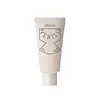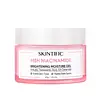What's inside
What's inside
 Key Ingredients
Key Ingredients

 Benefits
Benefits

 Concerns
Concerns

No concerns
 Ingredients Side-by-side
Ingredients Side-by-side

Water
Skin ConditioningButylene Glycol
HumectantCaprylic/Capric Triglyceride
MaskingGlycerin
HumectantCetearyl Alcohol
EmollientJojoba Esters
EmollientCetearyl Olivate
Niacinamide
SmoothingMangifera Indica Seed Butter
Skin ConditioningLimnanthes Alba Seed Oil
Skin ConditioningSorbitan Olivate
EmulsifyingEuphorbia Cerifera Wax
1,2-Hexanediol
Skin ConditioningIsododecane
EmollientSodium Polyacryloyldimethyl Taurate
Emulsion StabilisingEthylhexyl Palmitate
EmollientHydrogenated Polydecene
EmollientDimethicone/Vinyl Dimethicone Crosspolymer
Skin ConditioningGlycine Soja Seed Extract
Skin ConditioningSodium Hyaluronate
HumectantXanthan Gum
EmulsifyingCeramide NP
Skin ConditioningBetaine
HumectantAdenosine
Skin ConditioningBoswellia Serrata Resin Extract
SmoothingDisodium EDTA
Trideceth-10
CleansingMalt Extract
Skin ProtectingLactobacillus/Punica Granatum Fruit Ferment Extract
Skin ConditioningLactobacillus/Soybean Ferment Extract
Skin ConditioningLactobacillus/Pumpkin Ferment Extract
Skin ConditioningSimmondsia Chinensis Seed Oil
EmollientSaccharomyces/Grape Ferment Extract
Skin ConditioningEthylhexylglycerin
Skin ConditioningTocopherol
AntioxidantHydrogenated Lecithin
EmulsifyingStearic Acid
CleansingPropanediol
SolventBenzyl Glycol
SolventHydrolyzed Glycosaminoglycans
HumectantVincetoxicum Atratum Extract
Skin ConditioningCeramide Ns
Skin ConditioningSodium Hyaluronate Crosspolymer
HumectantCholesterol
EmollientPhytosphingosine
Skin ConditioningHydrolyzed Hyaluronic Acid
HumectantCeramide As
Skin ConditioningCeramide AP
Skin ConditioningHydroxypropyltrimonium Hyaluronate
Hyaluronic Acid
HumectantSodium Acetylated Hyaluronate
HumectantCeramide EOP
Skin ConditioningWater, Butylene Glycol, Caprylic/Capric Triglyceride, Glycerin, Cetearyl Alcohol, Jojoba Esters, Cetearyl Olivate, Niacinamide, Mangifera Indica Seed Butter, Limnanthes Alba Seed Oil, Sorbitan Olivate, Euphorbia Cerifera Wax, 1,2-Hexanediol, Isododecane, Sodium Polyacryloyldimethyl Taurate, Ethylhexyl Palmitate, Hydrogenated Polydecene, Dimethicone/Vinyl Dimethicone Crosspolymer, Glycine Soja Seed Extract, Sodium Hyaluronate, Xanthan Gum, Ceramide NP, Betaine, Adenosine, Boswellia Serrata Resin Extract, Disodium EDTA, Trideceth-10, Malt Extract, Lactobacillus/Punica Granatum Fruit Ferment Extract, Lactobacillus/Soybean Ferment Extract, Lactobacillus/Pumpkin Ferment Extract, Simmondsia Chinensis Seed Oil, Saccharomyces/Grape Ferment Extract, Ethylhexylglycerin, Tocopherol, Hydrogenated Lecithin, Stearic Acid, Propanediol, Benzyl Glycol, Hydrolyzed Glycosaminoglycans, Vincetoxicum Atratum Extract, Ceramide Ns, Sodium Hyaluronate Crosspolymer, Cholesterol, Phytosphingosine, Hydrolyzed Hyaluronic Acid, Ceramide As, Ceramide AP, Hydroxypropyltrimonium Hyaluronate, Hyaluronic Acid, Sodium Acetylated Hyaluronate, Ceramide EOP
Water
Skin ConditioningButylene Glycol
HumectantIsononyl Isononanoate
EmollientGlycerin
HumectantNiacinamide
SmoothingCeramide EOP
Skin ConditioningCeramide Ns
Skin ConditioningCentella Asiatica Extract
CleansingAlpha-Arbutin
AntioxidantCeramide NP
Skin ConditioningTranexamic Acid
AstringentCeramide As
Skin ConditioningCeramide AP
Skin ConditioningLimnanthes Alba Seed Oil
Skin ConditioningBetaine
HumectantJojoba Esters
EmollientHydroxyacetophenone
AntioxidantPanthenol
Skin Conditioning1,2-Hexanediol
Skin ConditioningCetearyl Olivate
Cyclohexasiloxane
EmollientSorbitan Olivate
EmulsifyingBis-PEG/PPG-20/5 PEG/PPG-20/5 Dimethicone
EmulsifyingMethoxy PEG/PPG-25/4 Dimethicone
EmulsifyingAcrylates/C10-30 Alkyl Acrylate Crosspolymer
Emulsion StabilisingDimethicone/Vinyl Dimethicone Crosspolymer
Skin ConditioningArmillaria Mellea Extract
Skin ConditioningPentylene Glycol
Skin ConditioningSaccharomyces Cerevisiae Extract
Skin ConditioningWater, Butylene Glycol, Isononyl Isononanoate, Glycerin, Niacinamide, Ceramide EOP, Ceramide Ns, Centella Asiatica Extract, Alpha-Arbutin, Ceramide NP, Tranexamic Acid, Ceramide As, Ceramide AP, Limnanthes Alba Seed Oil, Betaine, Jojoba Esters, Hydroxyacetophenone, Panthenol, 1,2-Hexanediol, Cetearyl Olivate, Cyclohexasiloxane, Sorbitan Olivate, Bis-PEG/PPG-20/5 PEG/PPG-20/5 Dimethicone, Methoxy PEG/PPG-25/4 Dimethicone, Acrylates/C10-30 Alkyl Acrylate Crosspolymer, Dimethicone/Vinyl Dimethicone Crosspolymer, Armillaria Mellea Extract, Pentylene Glycol, Saccharomyces Cerevisiae Extract
 Reviews
Reviews

Ingredients Explained
These ingredients are found in both products.
Ingredients higher up in an ingredient list are typically present in a larger amount.
1,2-Hexanediol is a synthetic liquid and another multi-functional powerhouse.
It is a:
- Humectant, drawing moisture into the skin
- Emollient, helping to soften skin
- Solvent, dispersing and stabilizing formulas
- Preservative booster, enhancing the antimicrobial activity of other preservatives
Betaine is a common humectant (a substance that promotes retention of moisture). It's known to be gentle on the skin and can help balance hydration.
This ingredient is best for improving hydration and soothing irritated skin. Studies also show it helps even out skin tone.
Fun fact: Betaine is naturally created in the skin and body. The kind found within cosmetic products can be either plant-derived or synthetic.
Another name for betaine is trimethylglycine.
Learn more about BetaineButylene Glycol (or BG) is used within cosmetic products for a few different reasons:
Overall, Butylene Glycol is a safe and well-rounded ingredient that works well with other ingredients.
Though this ingredient works well with most skin types, some people with sensitive skin may experience a reaction such as allergic rashes, closed comedones, or itchiness.
Learn more about Butylene GlycolCeramide AP is a type of Ceramide.
Ceramides are intercellular lipids naturally found in our skin that bonds dead skin cells together to create a barrier. Having a strong skin barrier leads to more firm and hydrated skin.
They are known for their ability to hold water and thus are a great ingredient for dry skin. By bolstering the skin ceramides act as a barrier against irritating ingredients. This can help with inflammation as well.
If you would like to eat ceramides, sweet potatoes contain a small amount.
Read more about other common types of ceramides here:
Ceramide NP
Ceramide EOP
Ceramide AS is a type of Ceramide.
Ceramides are intercellular lipids naturally found in our skin that bonds dead skin cells together to create a barrier. They are known for their ability to hold water and thus are a great ingredient for dry skin.
Ceramide EOP is a type of Ceramide.
EOP stands for a linked Ester fatty acid, a linked Omega hydroxy fatty acid, and the Phytosphingosine base.
Ceramides are intercellular lipids naturally found in our skin. They bind dead skin cells together to create a barrier. The ceramides in our skin have the ability to hold water to keep our skin hydrated.
Ceramides are an important building block for our skin barrier. A strong skin barrier helps with:
If you would like to eat ceramides, sweet potatoes contain a small amount.
Read more about other common types of ceramides here:
Learn more about Ceramide EOPCeramide NP is a type of ceramide.
Ceramides are intercellular lipids naturally found in our skin that bonds dead skin cells together to create a barrier. They are known for their ability to hold water and thus are a great ingredient for dry skin.
Ceramides are an important building block for our skin barrier. A stronger barrier helps the skin look more firm and hydrated. By bolstering the skin ceramides act as a barrier against irritating ingredients. This can help with inflammation as well.
If you would like to eat ceramides, sweet potatoes contain a small amount.
Read more about other common types of ceramides here:
Ceramide AP
Ceramide EOP
Ceramide NS is a type of Ceramide.
Ceramides are intercellular lipids naturally found in our skin that bonds dead skin cells together to create a barrier. They are known for their ability to hold water and thus are a great ingredient for dry skin.
Ceramide NG,Ceramide NS,1,3-Hexadecanediol, 2-Hexadecanamide,Palmitoyl-C16-Dihydrosphingosine,1-Stearoyl-C18-Sphingosine
Cetearyl Olivate is an emulsifier and texture enhancer. It is derived from the fatty acids of olive oil and Cetearyl alcohol, and is biodegradable.
As an emulsifier, it is used to prevent oils and waters from separating. It can also
Manufacturers use the name Olivem 1000. This ingredient has been found to preserve the natural microbiome of skin. Having a healthy microbiome helps keep our skin healthy and protects against harmful bacteria. This ingredient is grouped with Sorbitan Olivate under the name Olivem 1000.
Learn more about Cetearyl OlivateThis ingredient is a silicone used to improve the texture of products and absorb oil. It does not get absorbed into the skin.
Like other silicones, Dimethicone/Vinyl Dimethicone Crosspolymer helps condition the skin by creating a barrier. In this sense, it can act as an emollient and trap moisture in.
This ingredient is a type of elastomer.
Learn more about Dimethicone/Vinyl Dimethicone CrosspolymerGlycerin is already naturally found in your skin. It helps moisturize and protect your skin.
A study from 2016 found glycerin to be more effective as a humectant than AHAs and hyaluronic acid.
As a humectant, it helps the skin stay hydrated by pulling moisture to your skin. The low molecular weight of glycerin allows it to pull moisture into the deeper layers of your skin.
Hydrated skin improves your skin barrier; Your skin barrier helps protect against irritants and bacteria.
Glycerin has also been found to have antimicrobial and antiviral properties. Due to these properties, glycerin is often used in wound and burn treatments.
In cosmetics, glycerin is usually derived from plants such as soybean or palm. However, it can also be sourced from animals, such as tallow or animal fat.
This ingredient is organic, colorless, odorless, and non-toxic.
Glycerin is the name for this ingredient in American English. British English uses Glycerol/Glycerine.
Learn more about GlycerinJojoba Esters is a wax created from Jojoba oil. It is an emollient and film-forming ingredient. In bead form, it is an exfoliator.
This ingredient has high oxidative stability, meaning it doesn't break down when exposed to oxygen.
Its similarity to our skin's natural oils makes it a great emollient. Emollients help soften and soothe our skin by creating a barrier on top. This barrier helps trap moisture in, keeping skin hydrated.
It is created using either the hydrogenation or transesterification processes on jojoba oil.
Learn more about Jojoba EstersLimnanthes Alba Seed Oil is the oil extracted from the seeds of the meadowfoam plant. This oil is non-fragrant and is an emollient. As an emollient, meadowfoam seed oil helps soften and hydrate the skin.
Meadowfoam seed oil is stable and has a long shelf life due to its chemical structure. It has the highest concentration of stable fatty-acids among plant oils, preventing it from degrading once exposed to oxygen.
Due to the fatty acid content, this ingredient may not be fungal-acne safe.
Meadowfoam is native to California and Oregon.
Learn more about Limnanthes Alba Seed OilNiacinamide is a multitasking form of vitamin B3 that strengthens the skin barrier, reduces pores and dark spots, regulates oil, and improves signs of aging.
And the best part? It's gentle and well-tolerated by most skin types, including sensitive and reactive skin.
You might have heard of "niacin flush", or the reddening of skin that causes itchiness. Niacinamide has not been found to cause this.
In very rare cases, some individuals may not be able to tolerate niacinamide at all or experience an allergic reaction to it.
If you are experiencing flaking, irritation, and dryness with this ingredient, be sure to double check all your products as this ingredient can be found in all categories of skincare.
When incorporating niacinamide into your routine, look out for concentration amounts. Typically, 5% niacinamide provides benefits such as fading dark spots. However, if you have sensitive skin, it is better to begin with a smaller concentration.
When you apply niacinamide to your skin, your body converts it into nicotinamide adenine dinucleotide (NAD). NAD is an essential coenzyme that is already found in your cells as "fuel" and powers countless biological processes.
In your skin, NAD helps repair cell damage, produce new healthy cells, support collagen production, strengthen the skin barrier, and fight environmental stressors (like UV and pollution).
Our natural NAD levels start to decline with age, leading to slower skin repair, visible aging, and a weaker skin barrier. By providing your skin niacinamide, you're recharging your skin's NAD levels. This leads to stronger, healthier, and younger looking skin.
Another name for vitamin B3 is nicotinamide. This vitamin is water-soluble and our bodies don't store it. We obtain Vitamin B3 from either food or skincare. Meat, fish, wheat, yeast, and leafy greens contain vitamin B3.
The type of niacinamide used in skincare is synthetically created.
Learn more about NiacinamideSorbitan Olivate is created from the fatty acids in olive oil and sorbitol.
This ingredient is an oil in water emulsifier. It helps stabilize a product by preventing oils and waters from separating. Sorbitan Olivate also helps hydrate the skin.
Manufacturers sell sorbitan olivate under the name OliveM 1000. OliveM 1000 a multifunctional ingredient. It is self-emulsifying. According to a manufacturer, OliveM 1000 does not disrupt natural skin biome.
Due to its olive oil base, this ingredient may not be fungal-acne safe.
Learn more about Sorbitan OlivateWater. It's the most common cosmetic ingredient of all. You'll usually see it at the top of ingredient lists, meaning that it makes up the largest part of the product.
So why is it so popular? Water most often acts as a solvent - this means that it helps dissolve other ingredients into the formulation.
You'll also recognize water as that liquid we all need to stay alive. If you see this, drink a glass of water. Stay hydrated!
Learn more about Water